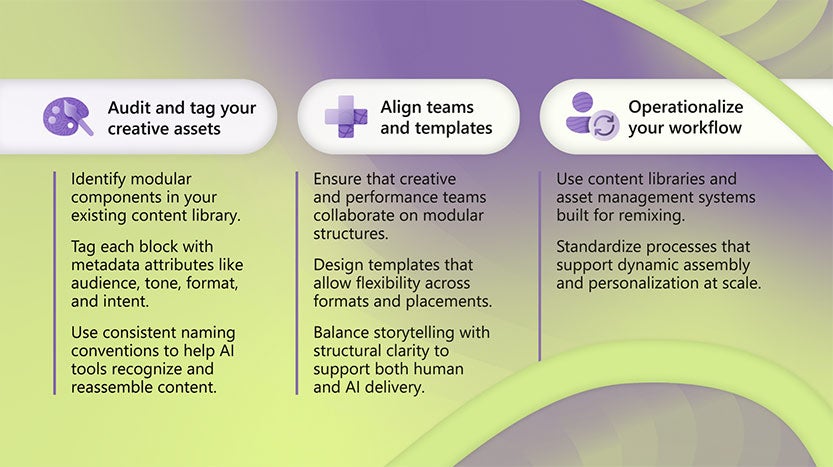Blog post
Building AI-ready creative: How modular content drives search advertising results

"AI is changing how we shop, and it’s happening faster than we expected. With Copilot and Bing, we’ve seen the path to purchase shrink by 30%. That’s not just efficiency—it’s a shift in how people make decisions.”
— Rukmini Iyer, Corporate Vice President, Microsoft
Content needs a new approach in the age of AI
AI is redefining how people search and what marketing creative needs to deliver. As users increasingly make decisions within a single, AI-powered interface, it’s harder to perfectly message map creative to our ideal personas throughout their buying journey.
Successful brands harness assets that are adaptable, scalable, and ready to respond instantly. Enter modular content: a smarter framework for structuring creative into flexible building blocks that can work across formats and channels.
As tools like Microsoft Copilot reshape where and how creative appears, modular content gives marketers the agility to show up with relevance in any moment of intent. Performance Max provides the easiest way to meet customers where they are with messaging that will resonate with them.
Modular content matters in AI-powered search
Modular content breaks campaigns into smaller, reusable blocks, such as headlines, benefits, images, proof points, and CTAs, each tagged with metadata for audience, intent, or format. These components can be mixed and matched across various touchpoints, including Copilot answers, paid search ads, social carousels, and beyond. The payoff is efficient personalization at scale, without duplicating production effort.
By contrast, traditional creative content is often locked in rigid formats, like PDFs or layered design files. These aren’t structured for AI to parse, repurpose, or deliver in real time. Modular content addresses this by providing AI with the flexibility to pull, recombine, and adapt messaging to suit individual journeys.
Generative AI and automation rely on content that’s clearly tagged, flexible, and set up for rapid interpretation. Modular content provides the blueprint these systems need to drive performance. Think of modular creative as a dynamic toolkit. One product benefit might appear as a search ad line, Copilot summary, or social caption, each block designed to be reused and adapted across formats.
Performance Max brings this concept to life by automatically selecting and assembling the ideal combination of assets for each user and context across Microsoft properties. That orchestration leads to real results: Retail advertisers using Performance Max saw 2.6x more site visits and 4.2x more conversions compared to non-users.1
Behind those results are well-structured modular creative provided by humans or consented creative pulled from the brand’s website. This creative adapts based on the surface and predictive signals about the user.
In short, AI systems respond with timeliness, precision, and personalization—without losing human creativity and strategy.
How Copilot uses modular content to personalize audience engagement
Copilot uses retrieval-augmented generation (RAG) and contextual logic to assemble responses in real time. Whether delivering a summary, an ad, or an answer, it draws from tagged modular content blocks to match a user’s query and context, eliminating the need for manual input.
The results speak for themselves. Ads in Copilot environments show 25% higher relevancy than traditional search ads, as measured by quick back rates.2 Chat-based shopping journeys also led to 194% more purchases immediately after interaction.3
By structuring content modularly, marketers can empower generative AI systems like Copilot to deliver faster, smarter, and more customized experiences at scale.
A 3-step supporting workflow to build modular content
Developing modular content starts by identifying components, like headlines, visuals, proof points, and CTAs, that can be reused across various formats. When these are structured with the right metadata and systems, marketers can adapt creative quickly across channels, audiences, and configurations.
Here’s how to make it work:

This “tagged modular content” foundation is what Copilot and Performance Max use to dynamically assemble custom messages and deliver tailored experiences that reflect user signals at scale.
Modular content is a performance advantage you can’t miss out on
Generative AI is accelerating how people search, shop, and decide, collapsing traditional funnels into faster, more fluid interactions. Modular content helps brands keep up, enabling greater agility, stronger personalization, and more consistent brand storytelling across channels—all while reducing the cost and effort of creative production.
As generative search reshapes the landscape and Microsoft continues to evolve Copilot, Bing, and ad solutions, modular content enables brands to show up smarter and keep pace with how and where people make decisions.
Our in-depth guide, The new search advertising landscape: How to win when AI is changing everything, explores how to build AI-optimized content that drives results and helps future-proof your brand. Download it today to access our unique AI toolkit for marketing transformation, along with strategic imperatives for marketing success in an AI-powered world.
We also recently hosted a webinar, if you missed it, you can still register to listen back and learn from our experts as they discuss the era of search advertising.
And if you’re new to Microsoft Advertising, take advantage of a free consultation with our team of experts to help you set up an account or get started today.
[1] Microsoft internal data, US, EMEA, July 2024
[2] Microsoft First Party Data | June 2024 - August 2024 | Comparison between similar serving positions in Search and Copilot
[3] Microsoft Copilot Insights - March 2025, Microsoft 1P Data | Dec 21, 2024 to Dec 31, 2024 | Global | Edge users | 30 minutes before and after Copilot interaction (Measured based on assumed purchases from URL address)
Your input makes us better
Take our quick 3-minute survey and help us transform your website experience.




